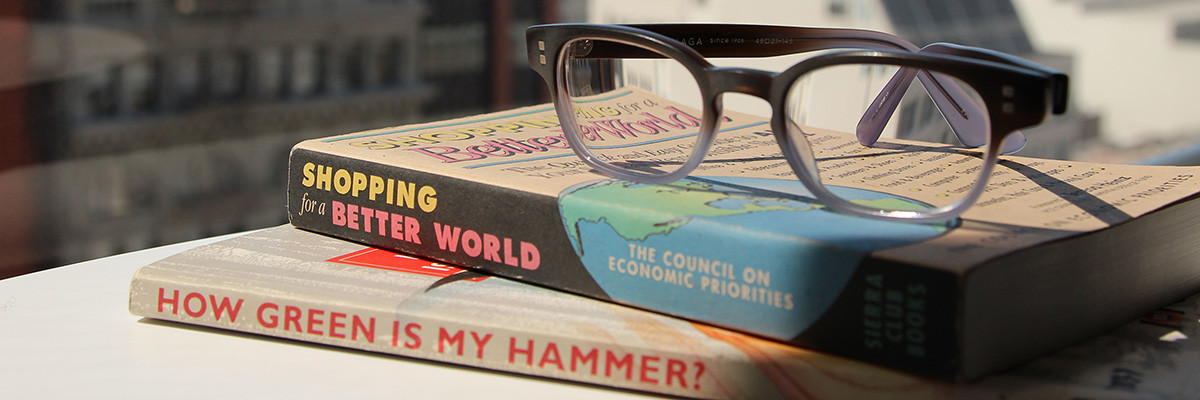
In the early 1990s, I was a teenage activist campaigning on environmental, labor, and human rights issues. Concerned about the abusive power of big business but not wanting to feel powerless, I purchased Shopping for a Better World by Alice Tepper Marlin.
I posted lists of companies to avoid on the family fridge, and over the summer holidays used my Brother word processor (the one where you could only see five lines at a time) to fire off letters to companies about their approach to climate change or abuse of human rights. Most replies were poor attempts at public relations, but one morning, with a thud, arrived B&Q’s 1993 environmental report, How Green Is My Hammer.*

Over 120 pages, the report diligently set out the company’s approach to the issues I cared about. It even described a new partnership between B&Q and WWF to establish a new organization called the “Forest Stewardship Council”—history in the making!
I realized that big business needn’t be the enemy but in fact had the promise to generate the change I wanted to see. I was awestruck. That life-changing experience left me with a strong affection for transparency, and twenty years later, here I am at BSR.
BSR’s 2014 Conference theme, Transparency and Transformation, has forced me to revisit the question of why transparency matters for sustainability. Its value has to go beyond teenagers misspending their youth reading sustainability reports.
For me, transparency matters for sustainability under the following conditions.
1. Transparency with a purpose. The trend toward organizations opening up huge data sets for use by others has great potential but doesn’t create value on its own. The real significance of transparency arises when data is harnessed for a sustainability purpose and has a clear end goal in mind—such as enabling investors or consumers to make informed decisions based on robust and comparable data. Our product transparency session will explore this theme.
2. Transparency that informs the public dialogue. Transparency has the power to demystify the cryptic and shed light on the unsolved. One of the fascinating features of the recent Snowden revelations on government surveillance has been the extent to which companies have used so-called “transparency reports” to increase awareness of the human rights issues at stake and create momentum for change. Our session on addressing tough issues through proactive transparency will explore this theme.
3. Transparency and responsibility. Think of a global problem these days and there is a big-data solution available—smart cities, buildings, agriculture, energy, and the like. But is big data always a good thing? We must think carefully about the consequences of using data to predict outcomes and make behavioral assumptions about individuals without their knowledge. Big Data: Friend or Foe? will explore the up- and down-side of transparency.
4. Knowing when not to be transparent. Companies are under increasing pressure to disclose findings from their human rights due diligence assessments. Investors, users, and other stakeholders need evidence that human rights risks have been systematically reviewed. But too much disclosure can create risk for the stakeholders whom assessments are meant to protect, or reduce companies’ ability to create change behind the scenes. Our Transparency in Human Rights Due Diligence session will explore this dilemma.
5. Listening to somebody else’s transparency. In today’s world, it can seem like we are exposed to a diversity of perspectives. Too often, however, it’s the reverse: We use the internet to surround ourselves with views that reinforce our own and disconnect from alternative points of view. This tendency to “flock together” is a key concern of I3 speaker Ethan Zuckerman.
In many ways, B&Q’s How Green Is My Hammer could not be more different from what you’d see today. The graphics are grainy, the charts are basic, and the photography reminds me of just how bad fashion was in the 1990s. However, re-reading the report, I’m struck by how relevant the content remains. For all our digital-age concern about the form that transparency takes, it is only by focusing on the purpose, responsibility, and substance of the information conveyed that transparency will achieve its potential.
* Translation for Americans: B&Q is the British version of Home Depot.
Learn more about the BSR Conference 2014, taking place in New York November 4-6.
BSR’s latest sustainability insights and events straight to your inbox.
Let’s talk about how BSR can help you to transform your business and achieve your sustainability goals.

